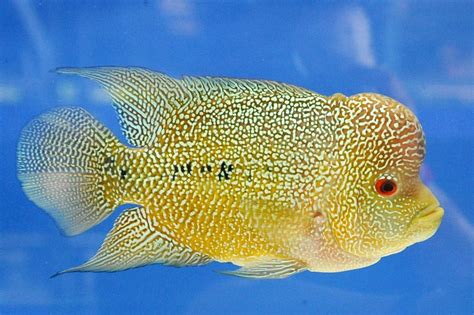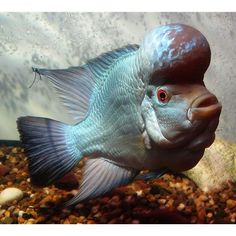
Delve deep into the world of aquatic life as we journey to explore the mesmerizing and unique species fondly known as the Big Forehead Fish. These intriguing creatures, with their distinctive appearance, are not usually part of mainstream marine talks, yet they add a spectacular touch of individuality to the vast oceanic canvas.
The Big Forehead Fish, scientifically recognized as Argyropelecus gigas, captures the fascination of marine biologists and aquatic enthusiasts alike. Their dome-like extended forehead earns them this unique name and sets them apart in the crowded underwater world. With this article, we illuminate the lesser-known facts and interesting traits of this peculiar species.
Understanding the world under the surface of our water bodies is not only enchanting but crucial to biodiversity conservation. Whether you’re an aspiring marine biologist, a dedicated environmentalist or someone simply captivated by the mysteries of the deep blue sea, the enigmatic Big Forehead Fish is bound to pique your curiosity. Join us, as we uncover the life of this extraordinary creature.
Unlocking the Mysteries of Big Forehead Fish
The Big Forehead Fish, or Callochromis Macrops as it is scientifically known, is unique species that lures biologists and aquarium enthusiasts worldwide. Notable for their pronounced forehead, these species hold many intriguing secrets.
They predominantly inhabit the water bodies of Central America, often found in groups. Observing them uncovers one of the many mysteries: they exhibit fascinating social behavior. Most of their socializing happens during feeding as they are nocturnal and spend a considerable time buried in the substrate during the day.
Another intriguing mystery lies in the pronounced forehead which is believed to play a significant role in their survival. According to some theories, the enlarged forehead stores fat, providing energy during food scarcity. Some scientists also argue that the forehead might be used to sense changes in water conditions or while locating food.
Unlocking these mysteries is a journey that expands our horizon in understanding this unique species. Whether it is the question of their unusual appearance or their intriguing social behavior, Big Forehead Fish truly pose an exciting subject of scientific study.
Overview of the Unique Big Forehead Fish Species
The Big Forehead Fish, scientifically known as “Hydrocynus forskahlii”, is a remarkable species that draws attention by their prominent forehead feature. This unique fish is known for its special physical characteristics and behavior patterns.
Physical Features

Their primary defining feature, the large forehead, is a bluish-gray hunch that is believed to house a large brain, giving these fish their distinctive appearance. Other characteristics include a long slim body covered in silver scales, with a dark blue or black back and a lighter underbelly. Adult Big Forehead Fish typically grow to around 30 to 35 cm in length.
Natural Habitat and Behavior
Big Forehead Fish are typically found in freshwater rivers and streams in Central Africa. They are powerful and opportunistic predators and have a carnivorous diet that mainly consists of other smaller fish and arthropods. Also, they are known for their aggressive and territorial nature.
-
Reproduction and Lifespan: Big Forehead Fish have a fascinating reproductive process, where the male guards the eggs after the female has laid them. Their average lifespan is around 10 years in the wild.
-
Use in Aquaristics: Some aquarium enthusiasts love to keep Big Forehead Fish as pets due to their unique appearance and observing their interesting behaviors proves enjoyable.
Characteristics of the Big Forehead Fish: Physical Features
The Big Forehead Fish, also known as the Flowerhorn Cichlid, is a hybrid fish that presents a unique blend of vibrant colors and distinctive physical attributes. Originating from Malaysia in the late 1990s, it has captured the interest of aqua enthusiasts all over the world.
Size and Shape
One of the most distinctive physical features of the Big Forehead Fish is its large, bulbous forehead, also known as a nuchal hump or “kok”. This protrusion, particularly developed in males, gives the fish its nickname. Males generally grow larger than females, with some males reaching a whopping 16 inches in length, while females typically measure up to 12 inches.
Color and Pattern
The Big Forehead Fish has a vivid display of color that further enhances its appeal. It boasts an array of hues that range from bright red and orange to captivating blues and greys. The unique mix of bold colors is complemented by complex and abstract patterns, which make each Big Forehead Fish appear as a living, swimming piece of art.
Another striking feature is their pearling. Pearl spots, or flower lines, are scattered across their bodies and provide an iridescent effect that’s truly mesmerizing when the light hits it right.
The eyes of the Big Forehead Fish are vibrant and expressive, typically exhibiting a fiery red color that complements their overall vivid palette. This arresting eye color is rare and captivating, adding to the fish’s exotic appeal.
In conclusion, the Big Forehead Fish is a creature of extraordinary beauty, its unique physical features ranging from its namesake ‘big forehead’ to its varying bright colors and mesmerizing patterns. Every feature contributes to the unique and captivating charm of this outstanding species.
Big Forehead Fish Habitat: Where they Prefer Living
The Big Forehead Fish, also known as Flowerhorn Cichlid, is a unique aquatic species, recognized worldwide for its vivid colors and distinctive large forehead. But where does this attractive fish prefer living?
Natural Habitat

Interestingly, the Big Forehead Fish does not have a natural habitat. This species is the result of careful selective breeding by humans. However, the ancestors of the Big Forehead Fish are native to South America. They live in the warm, slow-moving waters of the Amazon River.
Aquarium Settings
Since the Big Forehead Fish is a product of human intervention, it is mostly found in home aquariums. These captivating creatures appreciate aquariums that mimic the warm and slightly acidic waters of their ancestral home. As large and territorial fish, they require ample space to swim and flourish. They also appreciate a secure environment with caves or rocks where they can hide and mark their territory.Given the right conditions and care, the Big Forehead Fish can become a delightful addition to your aquarium, showcasing their vibrant shades and unique forehead.
Big Forehead Fish Behavior: Feeding and Mating Habits
The Big Forehead Fish, also known as the Flowerhorn Cichlid, exhibits unique and interesting behavior related to feeding and mating. Understanding these behaviors offers fascinating insights into this distinctive species.
Feeding Habits
This species is omnivorous, consuming a diet comprised of small fish, crustaceans, insects, and plant matter. They are known for their aggressive feeding habits, often consuming their meals voraciously. They have a heightened metabolism, which requires frequent feeding within the staples of the day.
The following table summarizes the feeding schedule of the Big Forehead Fish:
| Age | Feeding Frequency | Diet Composition |
|---|---|---|
| Young (0-4 Months) | 5-6 times a day | Small insects, crustaceans, and specially formulated fish food |
| Adult (5 Months onwards) | 2-3 times a day | A balanced diet of fish, crustaceans, insects, and plant matter |
Mating Habits
Big Forehead Fish display distinct courting and mating behaviors. During courting, the males exhibit vibrant coloration and perform exciting displays to attract females. Once a pair is formed, the female will lay hundreds of eggs on a flat surface. The male then fertilizes the eggs. Both parents then guard and care for the eggs until they hatch.
Understanding these feeding and mating behaviors provide valuable information for the ideal care and breeding of the Big Forehead Fish in captive environments.
Threats the Big Forehead Fish Endure: Conservation Status and Issues
The Big Forehead Fish, although uniquely remarkable in its own nature, is enduring an array of threats to their population. These threats, unfortunately, hit both ends of their lives; from eggs to fully grown adults.
Impact of Human Activities
The Big Forehead Fish’s habitat has been greatly affected by human activities. Water pollution caused by industrial waste, deforestation, and unsustainable fishing methods have heavily endangered their thriving ecosystem.
Climate Change
Climate change and the subsequent increased temperature of sea waters affect the number and spread of these fish. Warmer temperatures can change the food abundance in the seas, making it challenging for the Big Forehead Fish to find enough to eat.
Let’s take a closer look at the factors affecting their conservation currently:
| Threat | Impact | Efforts to Minimize |
|---|---|---|
| Pollution | Contaminates the water, affecting the fish’s health and multiplying rate. | Implement tighter regulations on industrial waste disposal, encourage the adoption of greener alternatives. |
| Climate Change | Alters the sea’s temperature and the fish’s food availability, thus affecting their survival. | Reduce global carbon emissions, advocate for the usage of renewable energy sources. |
| Overfishing | Reduces their population in a faster rate than they can reproduce. | Enforce laws for sustainable fishing, educate the public about the importance of maintaining a balanced marine environment. |
It is evident that action is needed to protect the Big Forehead Fish from endangerment. Through understanding and implementing efforts to minimize these threats, we can strive towards securing a safer environment for them.
Importance of the Big Forehead Fish: Roles in their Ecosystem
The big forehead fish, scientifically known as ‘Nuchal Hump Fish’, not only stands out due to its unique look, but also plays a significant role in maintaining the balance of its ecosystem. Just like other species, the Big forehead fish exhibits a number of pivotal roles, which range from being a consumer to being a prey.
Role as a Consumer
Primarily, the big forehead fish is an omnivorous creature, feeding on plankton, aquatic plants, small fishes and detritus. By doing so, they aid in controlling the population of these organisms, thereby preventing potential overpopulation that could be detrimental to the ecosystem.
Role as Prey
Despite its distinctive forehead and size, the big forehead fish falls prey to a number of predatory species, which include larger fishes, water birds, and even humans. As a result, they become an indispensable source of nutrients for these predators, further driving the energy cycle within their ecosystem.
In addition to the aforementioned roles, the big forehead fish also indirectly contributes to nutrient cycling. When they excrete, they return vital nutrients into the water, boosting the growth of aquatic plants. Moreover, their spawning behaviour has a spatial role within their habitat, driving both local and broad-scale biodiversity patterns, profoundly impacting their ecosystem.
Undoubtedly, the big forehead fish’s unique characteristics and the roles it plays within its ecosystem make it a compelling subject of study for marine biologists and a truly remarkable spectacle for general nature enthusiasts.
Question-answer,
What is the Big Forehead Fish?
The Big Forehead Fish is a unique aquatic species primarily known for its distinctive physical feature – a large forehead. This species is often found in freshwater environments. It’s a fish that has long intrigued scientists and fish enthusiasts alike because of its unusual feature.
Where is the Big Forehead Fish mainly located?
The Big Forehead Fish can be found globally but are primarily found in freshwater environments. They have been spotted in various bodies of water around the world, including rivers, lakes, and ponds. Although it’s not a species that is well known to the public eye, they are common in their distribution and can be found if searched for specifically.
What is the significance of the big forehead in the Big Forehead Fish?
The significant large forehead of the Big Forehead Fish is a unique adaptation that assists them in their environment. The enlarged forehead plays a role, as it is believed to assist with their buoyancy, allowing them to move easily throughout the water. Additionally, it is thought that this feature may serve a purpose in mating rituals or dominance displays among male fishes.
Why are scientists interested in the Big Forehead Fish?
Scientific interest in the Big Forehead Fish stems from its unique features and behaviors. The distinctive large forehead is an evolutionary adaptation that is not seen in many other species, making it a fascinating subject for further research. This fish may also provide insights into ecological adaptations and evolutionary development of different species. Consequently, studying the Big Forehead Fish may help scientists broaden their understanding of aquatic life and evolution.